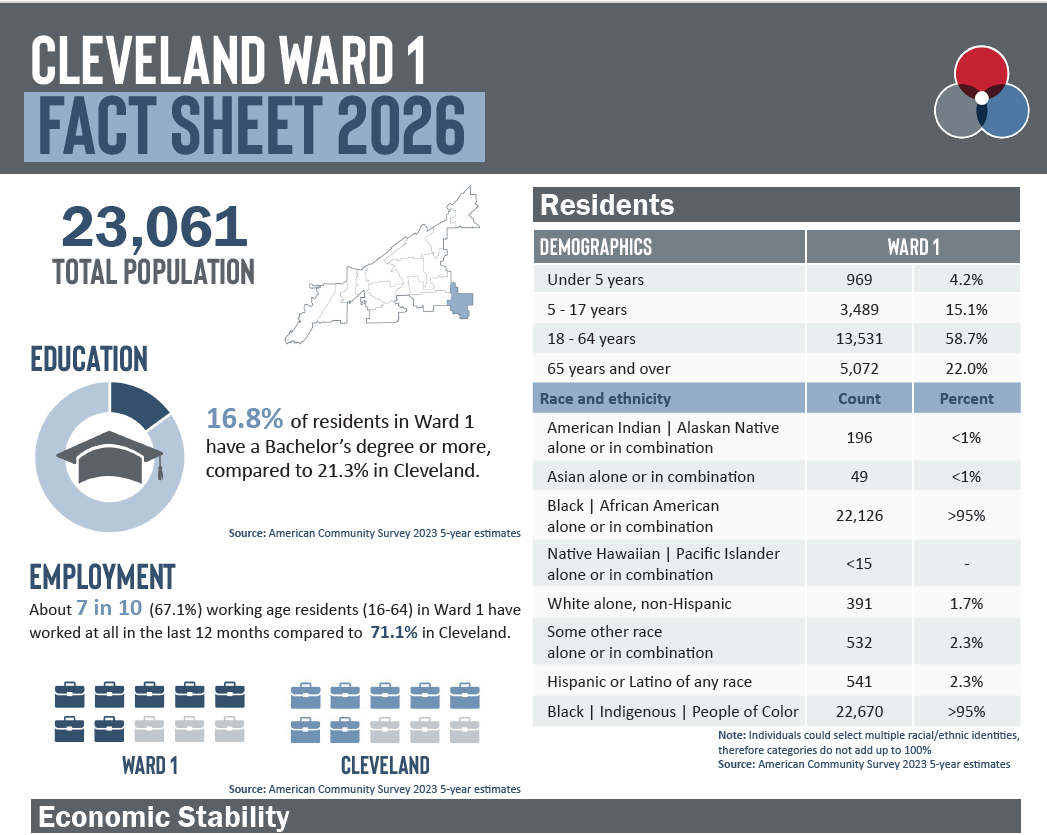At the start of the new year, an estimated seven in ten Clevelanders will be waking up in a new ward. The Center for Community Solutions is excited to announce the release of fact sheets and data profiles for the 2026 Cleveland Wards!
What is a ward?
The very first sentence I ever wrote for Community Solutions was “Cleveland is a city of neighborhoods.” An important addendum to that analysis: Cleveland is also a city of Wards. Every Clevelander lives in a ward, and each ward elects a councilperson every four years to represent the ward’s residents on Cleveland City Council.
Wards are redrawn every ten years with the release of the Decennial Census’ population numbers. For more information, check out Signal Cleveland’s in-depth reporting about the importance of wards and the redistricting process.
On every Clevelander’s mind right now…what is my new ward?
To account for population loss from 2010 to 2020, Cleveland’s wards were recently redrawn from 17 to 15 wards. These new wards will go into effect in 2026, after elections in September and November for new councilmembers.
To contextualize these new boundaries, Community Solutions created a tool that shows the estimated compositions of every wards’ population, by the percent of residents who live in the different neighborhoods found within each Ward.
- Select the ward you currently live in from the chart’s drop-down menu.
- Select your new ward from the second chart’s drop menu
- If you aren’t sure what your wards are, Cleveland City Council has a tool to show you your current ward and your new ward.
For example, I am currently in Ward 15, where close to half of my fellow ward members live in Detroit Shoreway, 30 percent live in Edgewater, and 23 percent live in Cudell. In my new ward (11), the neighborhood composition is completely different!
Thirty percent of Ward 11 residents live in West Boulevard, twenty-seven percent live in Old Brooklyn, and three percent live in Stockyards. Detroit Shoreway (17 percent), Edgewater (2 percent), and Cudell (20 percent), comprise a much smaller proportion of my new ward’s residents. These estimates were created by mapping residential parcel data from Cuyahoga County's Enterprise GIS Department, and making estimates of resident population by residential parcel type.
Go check them out!
We hope you find these new resources helpful for your work and your advocacy! We have also developed an accompanying resource, a worksheet to help you deepen your understanding of your ward (or neighborhood).
A quick reminder, “fact sheets” are shorter, meant to be quickly digestible
Data profiles contain all the same information found in the fact sheets in much more detail.
Data profiles are longer, prioritizing density over data visualization
Both have been painstakingly designed by Communications Associate Madison Van Epps to be visually appealing.
If you have any questions, feel free to reach out at info@communitysolutions.com. If you are interested in a complete methodology of how these resources were created, stay tuned!
Explore both sets of fact sheets referenced here
Cleveland Ward Fact Sheets 2026
Cleveland Neighborhood Fact Sheets
A special thanks to the Cleveland Foundation for their generous funding to create these resources, and to Dr. Stephanie Pike-Moore, who provided exciting new ward-level data from the 2025 Cleveland Health Survey.


.png)


.png)
.png)


